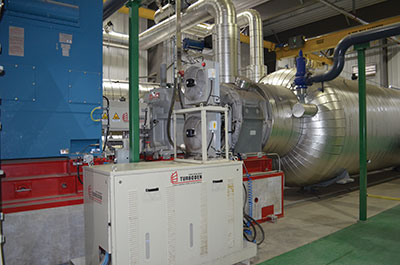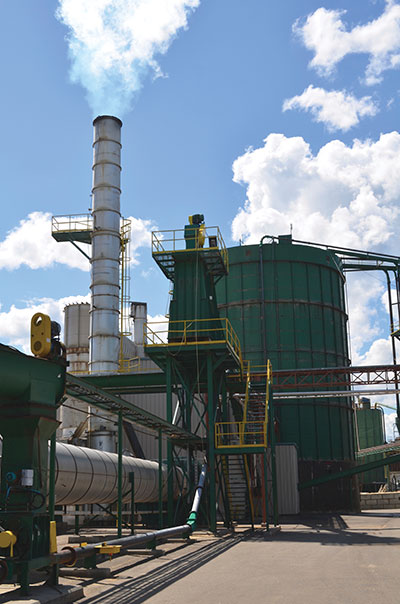
Power play
December 5, 2014
By
Andrew Macklin
Forty -five years later, Nechako is still using innovation to drive its business forward.
Forty -five years later, Nechako is still using innovation to drive its business forward.
 |
|
| The Organic Rakine Cycle provides approximately 25 per cent of the energy demands of the entire Nechako operation.
|
Built in the geographical centre of B.C. in 1969, the Vanderhoof-based business has grown from a simple planer mill to a multi-faceted wood products operation. The planer mill was complemented with a sawmill in 1972 before adding a pellet mill in 1998. Along the way, the company used innovation to spur its growth, becoming the first sawmill in North America to use a Hew Saw for small profile lumber and the first Canadian sawmill to sell stud lumber into the Japanese market.
The construction of the pellet mill, which began at a smaller scale than its current operation, was part of the company’s continuing effort to drive forward through innovation.
“One of the long-term objectives that the company had was full fibre utilization,” explains Alan Fitzpatrick, president of Nechako Green Energy. “One of the steps the shareholders took was to shut down the beehive burner. We then added a pellet plant and a thermal oil system.”
With both systems operational, the company then turned to major upgrades in the sawmill and the new pellet plant. In the mill, significant upgrades were made to optimization equipment on the saw lines, and grade scanning technology was added in the planer mill. The pellet plant saw a substantial increase in capacity, moving from two to four Bliss pellet mills as well as adding a MEC dryer to meet the demands of the increase in production capacity.
The upgrades to both mills continued the driven-by-innovation mantra that had kept Nechako pushing towards full fibre utilization. But at the same time, it created an unanticipated byproduct in abundance: heat. While not a problem for the operation, as ventilation to atmosphere removed the heat to prevent it from becoming an issue, it was a conundrum that needed consideration.
In 2010, after working its way through the heart of the recession, Nechako focused on how to approach using the excess heat as a resource for its operation. The company set an objective to become a more energy-efficient operation, using the heat as a key resource for meeting its goal.
After significant due diligence lasting nearly two years, Nechako decided that the best system to invest in was an Organic Rankine Cycle. The ORC uses an organic fluid that vapourizes at a lower temperature than the change from water to steam. The vapour then passes through a turbine to generate electricity. To complete the cycle, the fluid is cooled, condensed and brought back into the beginning of the loop.
Nechako’s research into the ORC technology led them to Italy-based Turboden, one of a handful of global manufacturers of the system.
“Turboden’s technology was the one that best fit what our operation was,” says Fitzpatrick. “The Turboden ORC is a very efficient form of electricity creation.”
Grant opportunities
In 2010, around the same time that Nechako began its research into what to do with excess heat, the Government of Canada announced the creation of the IFIT program.
 |
|
| An expansion created an unanticipated abundance of heat, a resource that could be reused in mill operations.
|
The Investments in Forest Industry Transformation program was an initiative of the Ministry of Natural Resources, providing $100 million in non-repayable contributions of up to 50 per cent for capital investment in new technologies over four years. The first and second call combined (Nechako applied during the first call) produced 107 applications from across the country.
Based on the strength of its application and, presumably, the company’s track record of innovation, Nechako was successful in its bid to receive IFIT funding to cover part of the cost of the acquisition, transport and building infrastructure cost of the ORC. The release sent in regards to Nechako’s successful application stated that the technology being incorporated by the company has “significant potential for replication across the industry.” In total, Nechako was given $2.1 million of the budgeted $6.8 million project.
Construction and installation of the ORC began in July of 2012 and was completed in March of 2013. The project was completed both on time and on budget. Day-to-day operation of the ORC involves two staff per shift, who monitor the system’s performance through an electronic tracking system, spitting out real-time data on a computer located in a secondary office adjacent to the ORC.
At current operation levels, the ORC provides approximately 25 per cent of the energy demands of the entire Nechako operation. That’s enough electricity generation to offset most of the energy demands of operating the pellet plant, which produces upwards of 180,000 tonnes of pellets per year.
Monetarily, the cost savings of using the ORC are significant for the operation. Even more so now, as the B.C. Government announced a 15.6 per cent hike in power rates over a two-year period back in November of 2013. That rate could jump even higher if demand continues to rise in the province and the government leans on energy rates to help pay off increasing debt.
In addition to the financial benefits of the installation of the ORC, Nechako is also experiencing a positive bump in its reputation both in the community and in the forestry sector.
“It reinforced our position in the industry as a leader in innovation and technology,” says Fitzpatrick. “It also raised our profile in the community as a good corporate citizen. It helped the community see that this company is spending money on becoming more energy efficient.”
The investments also sent a clear signal to employees that the company plans to continue its operation in Vanderhoof long into the future. After the impact of the recession a few years ago, that’s welcome news for workers in the forest industry.
“For our employees, I heard a number of times that they were excited that the shareholders were prepared to invest in the operation. That gave the employees the understanding that we’re here for the long haul.”
A bright future
Even though Nechako has invested so heavily since 2000, the company continues to identify ways to improve its operation.
According to Fitzpatrick, one of the original company directives still has not been completely met. “We have focused on full fibre utilization at our plant site. Our next opportunities will come from the utilization of our harvesting fibre as well.”
That could lead to an expansion of Nechako’s current operation in the foreseeable future, as well as the potential for new business opportunities.
Fitzpatrick also insists that more work can be done to address the issue of heat on the plant site in an effort to maximize all resources available for energy generation.
“We still have heat that we can use; the ORC does not consume all of the heat. We have a number of different options. We are evaluating all of the different options that we have right now.”
Print this page